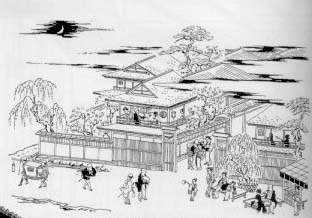

The spawning grounds of towsmen culture during the 1600s were the pleasure and entertainment quarters that formed within the great cities.
The pleasure quarters of Edo-period Kyoto was initially the Rokujo-Misujimachi, located in the south-central part of the city, about one kilometer north of the present Kyoto station. The shogunate eventually became alarmed at Rokujo-Misumachi's growing popularity and ordered it to move to a more remote area just west of Nishi Honganji temple, where it became known as Shimabara. Kyoto's pleasure quarters were surrounded by a moat and a wall with a great gate at the east, making it look from the outside as much like a fortress as an entertainment area. The quarter was divided by one road going east and west and three north and south, initially arranged in such a way as to form six blocks.
The women of the quarter lived in residences called akiya, meaning "storehouse," and went out to entertain customers at houses of assignation (ageya). The Sumiya house of assignation in Shimabara is the only one that remains in more or less complete form. It combines the taste and craftsmanship of the Sukiya style with the flair of the "floating world" of the courtesans. Passing through the front gate of Sumiya, one first enters a pleasant courtyard. Directly ahead is the entrance to the kitchens, and the formal entry alcove is to the right. From the street, one can see the outside of three rooms on the second floor, the Ogi no Ma, Suiren no Ma, and Donsu no Ma. The shoji-screened outer walls of both the first and second floor are recessed half a bay and fronted by wooden grills, giving visual unity to the facade. In the rear of the Sumiya is a gracious garden and a teahouse.
|
|